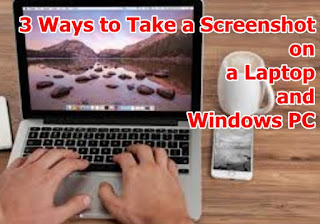
Want to take a screenshot on a laptop or PC but don't know how? In this article, InfoPonsel will explain 3 ways to take screenshots on Laptop / PC - some of which you may not have known before.
How to Screenshot 1: Use Print Screen
This is a way to take screenshots on laptops and PCs that are best known and used by Windows users - using the Print Screen button on the keyboard.
But what not many people know is that taking screenshots using Print Screen varies:
- Take screenshots without saving as a file, only saved to the clipboard.
- Take screenshots and automatically save as a file
- Taking screenshots is only one active window, not the entire screen
-
Taking a Screenshot without Saving as a File
The trick is just to press the Print Screen button (on some laptops sometimes you need to press Fn + PrtScn).It won't look anything after you press the Print screen button, but the screen capture will be saved on the Clipboard.
Now you can just open your favorite Image Editor application (for example MS Paint), and paste it. The screenshot will be posted right there and ready for you to save or if you go further.
-
Taking Screenshot and Saving as a File
How to screenshot PC by directly saving it as a file only valid in Windows 8.1 and above (including Windows 10). The trick, just press the Win + Print screen button (on some laptops sometimes you have to press Win + Fn + PrtScn or Win + Ctrl + PrtScn). The win is a button with a Windows logo on the keyboard).After you press the key combination, the screen will flash for a moment and the screenshot file will be saved in Pictures> Screenshots. You can take screenshots many times and automatic screenshot files are made with numeric labels.
-
Taking an Active Window Screenshot
The trick, just click on the title bar window that you want to screenshot, then press Alt + PrntScr - or on some laptops you might have to press Alt + Fn + PrntScr.The screenshot will be stored directly on the clipboard and you can paste it through an image editor such as MS Paint or something else.
How to Screenshot 2: Using the Snipping Tool
Snipping Tool is a Windows default tool that has been around since Windows Vista. Unfortunately, not everyone has used it. Even though with Snipping Tool you can take screenshots in Windows with far more flexibility.With the Cut Tool you can take a screenshot:
- Full screen
- Active window screen
- Desired screen section (rectangle and free shape)
There is one additional feature in the Snipping Tool in Windows 10 that is not owned by the Snipping Tool in previous versions of Windows, namely Delay.
This allows you to be more flexible in managing how long the Snipping Tool will take screenshots since it's activated. So there is an opportunity for you to move and operate the mouse in order to take screenshots of popup, tooltips, or other elements.
Method 3: Using Screenshot Software
If using the manual method via Print screen or Snipping Tool is not able to meet your needs, you can use screenshot software, the majority of which have more complete features than the default tool.One of my favorite screenshot software is PicPick, which, besides its full features, is also equipped with an image editor, so you can directly add text, arrows, blur, or other information you need.
PicPick is very useful for those of you who often write tutorials on blogs or are creating books/eBook guides.
That's 3 ways computer screenshots that you can easily practice. Have tips and other screenshots? Please divide in the comments column.
Comments
Post a Comment